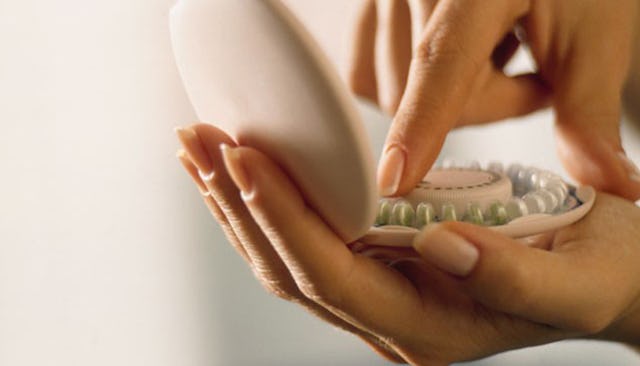Breaking Down Birth Control Options

Whether you are planning on having children just not yet, or already have a child/children and want more, but right now you need a moment to catch your breath and try to keep it together, figuring out the right type of birth control (other than abstinence) can be tricky. Condoms, and patches, and pills, OH MY!! It can be overwhelming, and every person is different, so you need to use what is best for you, a fast-paced woman on the go, who most likely doesn’t want to have to think about birth control. Let’s lay your birth control options out there:
RELATED: What Is Sex With An IUD Like? Is Rough Sex OK? All Your Pressing Questions, Answered
Condoms: Condoms (both male and female) are great, but you have to actually HAVE them available and USE them (it’s a two-step process that sometimes is missed), and I find that many couples ditch the condoms once they get married as a finale to their dating days. They are pretty cheap, just require a quick stop to the local store, are pretty effective, 99.9%, when used correctly, and when you decided you want to try again, you can just ditch the condoms.
The Pill/Patch/Ring: can be great, but they all are varied doses of hormones, which I know many people do not feel comfortable with, or they can’t for various medical reasons. To be most effective, the pill has to be taken at the same time every day (and if you’re anything like me, I’m lucky to put on underwear right side out some days, so who can remember that?!?) You do need to change your patch, and make sure that it stays intact to your skin (if it falls off and you don’t notice, that would be a bummer.) And you also need to remember to change your ring, and check that it’s up there near your cervix every now and again. All of these are usually covered by insurance and pretty cost effective, however refills usually require annual GYN visits, and they are very effective, 99.9%, when used perfectly. There is also some turn around time when you stop using hormonal birth control and when it totally leaves your system so you are fertile again (this can range from a month to 6 months to a year- all person dependant.)
Diaphragms & Spermicide: Diaphragms (that you usually fill with a spermicidal gel or foam) are small dome shaped silicone cups that have to be fitted by your GYN, and they fit right over your cervix and should be placed up to an hour before sex (to work best). They are pretty inexpensive (usually $20-$75) and they last two years before requiring a refitting, they are slightly less effective than other methods, 92%, when used religiously. They are easily portable, can be difficult for some women to place, but a good hormone-free option that is easily reversible, so no long-term planning when you want to try for a baby, just leave the diaphragm out of the equation.
Intrauterine Devices (IUDs): IUDs are small plastic T-shaped devices that either have small dose hormones (that can sty in place for 3-5 years) or are coated in copper (which can stay in place up to 10 years.) They are both highly effective at preventing pregnancy, 96-99%, they are put in place by your Healthcare Practitioner (HCP), and left in place until either they need to be replaced or you have decided it’s time to try to get pregnant. You do need to check that the string hanging from the IUD is felt coming from your cervix after each period (very important), if you can’t feel it, it may have become dislodged, however it tends to be more comfortable during placement and more likely to stay in place for women who have already had a child previously. Once an IUD is removed, even with the hormonal version, the effects are reversed quickly and most women get pregnant very quickly. (IUDs got a bad rap years ago, but these are a whole new kind of IUD!)
Natural Family Planning: You can track your ovulation days (there are even apps that can help you with this and send you reminders of when you are ovulating once you get your tracking down) which can be a little tricky at first, gong off of temperature changes, and then peeing on ovulation sticks (which are quite pricey) to confirm your cycles. But once most people get it down, they learn how their body feels and they know when they are ovulating. The downside is that if you are using no other barrier method, and are either abstaining when you are ovulating, or using the old “pull and pray” method, is that people forget that sperm can live in the cervix/uterus for up to three days; if you are off with your timing, or your body doesn’t work like clockwork, you may be in for a little surprise earlier than planned. But, when this is tracked properly, there is a 95% rate of effective family planning, and because there are no hormones at play, whenever you want to try for that bundle of joy, you can!
Obviously not every method is 100% effective, and maybe because of kids, work, life, being a mom, and being a wife can get the best of you, non-planned abstinence might be your current birth control, which also gets the job done. There are pros and cons to each method; it just has to be feasible for you to stick to it. But, I said before, everyone is different, and what works best for you and your partner, for whatever reason, go for it, and take a moment to enjoy yourself before trying for that little one!
This article was originally published on